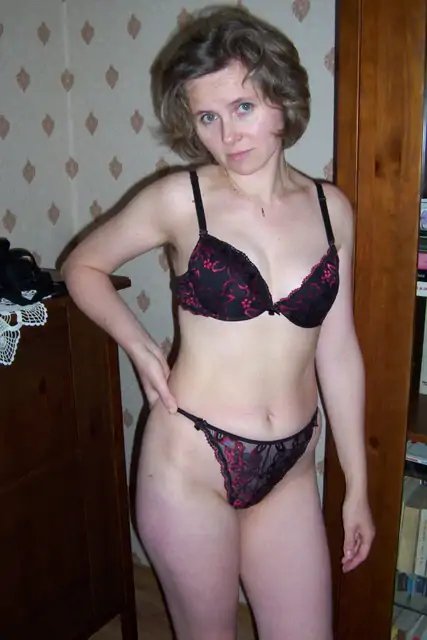Lingerie

Lingerie
Lingerie (UK: /ˈlæ̃ʒəri, ˈlɒn-, -ʒəreɪ/, US: /ˌlɒnʒəˈreɪ, ˌlænʒəˈriː/[1]; French: [lɛ̃ʒ.ʁi]) is a category of women's clothing including at least undergarments (mainly brassieres), sleepwear and lightweight robes. The specific choice of the word often is motivated by an intention to imply the garments are alluring, fashionable or both.
Lingerie is made of lightweight, stretchy, smooth, sheer or decorative fabrics such as silk, satin, Lycra, charmeuse, chiffon or (especially and traditionally) lace. These fabrics can be made of natural fibres like silk or cotton or of synthetic fibres like polyester or nylon.
Etymology
The word lingerie is a word taken directly from the French language, meaning undergarments, and used exclusively for more lightweight items of female undergarments.[2] The French word in its original form derives from the old French word linge, meaning 'linen'. So faire le linge, comes to mean "do the laundry". In English it means women's underwear or nightclothes.[3]*%2C%209th%20ed%2C%20p792.]]*ingerie as a word was first used to refer to underwear and bras in 1922.erotic clothing. Although most lingerie is designed to be worn by women, some manufacturers now design lingerie for men.
Origins
The concept of lingerie is a visually appealing undergarment that was developed during the late nineteenth century.
Lady Duff-Gordon of Lucile was a pioneer in developing lingerie that freed women from more restrictive corsets. Through the first half of the 20th century, women wore underwear for three primary reasons: to alter their outward shape (first with corsets and later with girdles or brassieres), for hygienic reasons and for modesty. Before the invention of crinoline, women's underwear was often very large and bulky.
During the late 19th century, corsets became smaller, less bulky and more constricting and were gradually supplanted by the brassiere, first patented in the 20th century by Mary Phelps Jacob. When the First World War broke out, women found themselves filling in men's work roles, creating a demand for more practical undergarments. Manufacturers began to use lighter and more breathable fabrics. In 1935 brassières were updated with padded cups to flatter small breasts and three years later underwire bras were introduced that gave a protruding bustline. There was also a return to a small waist achieved with girdles. The 1940s woman was thin, but had curvaceous hips and breasts that were pointy and shapely. In the 1960s the female silhouette was liberated along with social mores. The look was adolescent breasts, slim hips and extreme thinness. André Courrèges was the first to make a fashion statement out of the youth culture when his 1965 collection presented androgynous figures and the image of a modern woman comfortable with her own body.[5]
As the 20th century progressed, underwear became smaller and more form fitting.
In the 1960s, lingerie manufacturers such as Frederick's of Hollywood begin to glamorise lingerie. The lingerie industry expanded in the 21st century with designs that doubled as outerwear. The French refer to this as 'dessous-dessus,' meaning something akin to innerwear as outerwear.[6]
Market structure
The lingerie market at the turn of the 21st century was driven by the advent of modern technologies and fabrics that help in designing innovative products such as laser-cut seamless bras and moulded T-shirt bras. Designers are putting greater emphasis on rich-looking fabrics, laces, embroideries and brighter colours.
The global lingerie market in 2003 was estimated at $29 billion, while in 2005, bras accounted for 56 per cent of the lingerie market and briefs represented 29 per cent. The United States’s largest lingerie retailer, Victoria's Secret,[7] operates almost exclusively in North America, but the European market is fragmented, with Triumph International and DB Apparel predominant.[8] Also prominent are French lingerie houses, including Chantelle, Aubade and Simone Pérèle, each with a long history and a commitment to innovation and French style. Since the mid-1990s, women have had more choice in bra sizes; the focus has changed from choosing bras in an average size to wearing bras that actually fit perfectly. In the UK, for instance, the media are fuelling an awareness campaign about the need for each woman to have a proper bra fitting before every purchase.
Typology
Babydoll, a short nightgown, or negligee, intended as nightwear for women. A shorter style, it is often worn with panties. Babydolls are typically loose-fitting with an empire waist and thin straps.
Basque
Bloomers
Bodystocking
Bodice
Brassiere
Bustier
Camisole, sleeveless and covering the top part of the body. Camisoles are typically constructed of light materials and feature thin "spaghetti straps".
Chemise
Corset, a bodice worn to mould and shape the torso. This effect is typically achieved through boning, either of bone or steel.
Corselet, or merry widow, combined brassiere and girdle. The corselet is considered to be a type of foundation garment, and the modern corselet is most commonly known as a shaping slip.
G-string, orthong
Garter**/** rter belt**/Suspender belt (British), used to keep stockings up.
Girdle, a type of foundation garment. Historically, the girdle extended from the waist to the upper thigh, though modern styles more closely resemble a tight pair of athletic shorts.
Hosiery
Negligee
Nightgown, or nightie, a loosely hanging item of nightwear, may vary from hip-length (babydoll) to floor-length (peignoir).
Nightshirt
Panties or knickers, a generic term for underwear covering the genitals and sometimes buttocks that come in all shapes, fabrics and colours, offering varying degrees of coverage.
Petticoat, an underskirt. Petticoats were prominent throughout the 16th to 20th centuries. Today, petticoats are typically worn to add fullness to skirts in the Gothic and Lolita subcultures.
Pettipants
Tanga
Tap pants
Teddy
See also
Andrés Sardá
Hosiery
Olga Erteszek
Underwear as outerwear
Wonderbra
